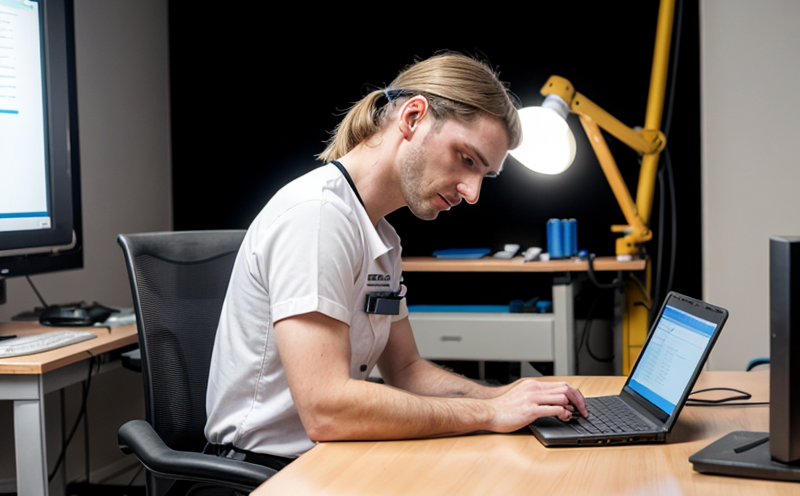SAE ARP 60493 Human Factors Environmental Stress Testing
The SAE ARP 60493 standard is pivotal in ensuring that aerospace and aviation products meet stringent human factors environmental stress testing requirements. This service focuses on assessing the durability, reliability, and safety of components under a range of challenging conditions to ensure they perform consistently across all operational environments. The test parameters are designed to mimic real-world scenarios, including temperature extremes, humidity, vibration, and pressure changes.
The process begins with thorough specimen preparation, which involves selecting materials that accurately represent the end product. This ensures that the testing is as realistic as possible, leading to more accurate and reliable results. Once prepared, the specimens are subjected to various environmental stressors using state-of-the-art equipment. The key parameters tested include temperature cycling from -65°C to +125°C, humidity levels up to 98% relative humidity, and vibration forces that simulate flight conditions.
The SAE ARP 60493 standard emphasizes the importance of ergonomics in design and functionality. Ergonomic considerations ensure that pilots and crew can operate controls efficiently even under extreme environmental conditions. This includes testing for reachability, visibility, control layout, and overall comfort. The test results are meticulously recorded and analyzed to identify any potential weaknesses or areas for improvement.
The acceptance criteria for this service are based on the SAE ARP 60493 standard, which sets out clear guidelines for passing these tests. Components must withstand a minimum number of cycles without failure, maintain their functional integrity under specified environmental conditions, and meet ergonomic requirements as defined in the standard.
- Temperature cycling: -65°C to +125°C
- Humidity levels up to 98% relative humidity
- Vibration forces simulating flight conditions
The testing process is not only rigorous but also highly detailed, ensuring that every aspect of the product is evaluated. This level of scrutiny guarantees that aerospace and aviation products are robust and reliable, enhancing safety and performance.
Benefits
The SAE ARP 60493 Human Factors Environmental Stress Testing service offers numerous benefits to stakeholders in the aerospace and aviation sectors. By adhering to this standard, manufacturers can ensure that their products meet regulatory requirements and industry best practices. This not only enhances product quality but also builds trust with customers and regulators.
Compliance with SAE ARP 60493 ensures a consistent approach to testing across the industry, promoting uniformity in standards and procedures. It provides peace of mind for quality managers and compliance officers by offering a clear pathway to meet regulatory expectations. For R&D engineers and procurement teams, this service streamlines the product development process, reducing time-to-market and minimizing costly rework.
Moreover, successful completion of these tests can significantly enhance the reputation of an organization within the industry. It demonstrates a commitment to excellence and sets a benchmark for quality in aerospace and aviation products. This can lead to increased market share and stronger customer relationships.
Environmental and Sustainability Contributions
- The testing ensures that components are durable under harsh conditions, reducing the likelihood of premature failure in service.
- Ergonomic design considerations can lead to more efficient operations, potentially reducing fuel consumption and emissions over a product's lifecycle.
- Robust products contribute to safer flights, which is crucial for environmental safety and sustainability.
The SAE ARP 60493 standard helps in achieving these goals by providing a structured approach to testing that focuses on both performance and ergonomics. By ensuring that components perform reliably under extreme conditions, the service supports sustainable practices within the aerospace industry.
Competitive Advantage and Market Impact
The SAE ARP 60493 Human Factors Environmental Stress Testing is a critical differentiator in the competitive landscape of aerospace and aviation. By offering this service, organizations can position themselves as leaders in quality and reliability. This enhances their reputation among customers and stakeholders, fostering long-term relationships.
Compliance with SAE ARP 60493 standards also opens doors to new markets and opportunities for expansion. It demonstrates a commitment to excellence that can attract investment and partnerships. Furthermore, the ability to offer this service can set a company apart from competitors, making it more attractive to potential clients.
Ultimately, the market impact of this testing is profound. Products that pass these tests are more likely to gain acceptance in the industry, leading to increased sales and market penetration. This not only benefits the organization but also contributes positively to the overall aerospace and aviation ecosystem.





